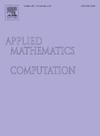Signed total Roman domination and domatic numbers in graphs
IF 3.5
2区 数学
Q1 MATHEMATICS, APPLIED
引用次数: 0
Abstract
A signed total Roman dominating function (STRDF) on a graph G is a function satisfying (i) for each vertex and its neighborhood in G and, (ii) every vertex with , there exists a vertex with . The minimum number among all STRDFs f on G is denoted by . A set of distinct STRDFs on G is called a signed total Roman dominating family on G if for each . We use to denote the maximum number of functions among all signed total Roman dominating families on G. Our purpose in this paper is to examine the effects on when G is modified by removing or subdividing an edge. In addition, we determine the number for the case that G is a complete graph or bipartite graph.
图表中的罗马人统治总数和统治人数签名
图 G 上的有符号总罗马占优函数 (STRDF) 是一个函数 f:V(G)⟶{-1,1,2},满足:(i) 对于 G 中的每个顶点 ux∈V(G) 及其邻域 NG(u),∑x∈NG(u)f(x)≥1;(ii) f(u)=-1 的每个顶点 u∈V(G),都存在 f(v)=2 的顶点 v∈NG(u)。在 G 上的所有 STRDF f 中,∑u∈V(G)f(u) 的最小数目用 γstR(G) 表示。如果对于每个 u∈V(G),∑i=1dfi(u)≤1,则 G 上不同 STRDF 的集合 {f1,...,fd}称为 G 上的有符号总罗马支配族。我们用 dstR(G) 表示 G 上所有有符号罗马支配族中函数的最大数目。本文的目的是研究当通过删除或细分一条边来修改 G 时对γstR(G) 的影响。此外,我们还确定了 G 是完整图或二叉图时的 dstR(G) 数。
本文章由计算机程序翻译,如有差异,请以英文原文为准。
求助全文
约1分钟内获得全文
求助全文
来源期刊
CiteScore
7.90
自引率
10.00%
发文量
755
审稿时长
36 days
期刊介绍:
Applied Mathematics and Computation addresses work at the interface between applied mathematics, numerical computation, and applications of systems – oriented ideas to the physical, biological, social, and behavioral sciences, and emphasizes papers of a computational nature focusing on new algorithms, their analysis and numerical results.
In addition to presenting research papers, Applied Mathematics and Computation publishes review articles and single–topics issues.

 求助内容:
求助内容: 应助结果提醒方式:
应助结果提醒方式:


